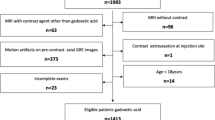Abstract
Purpose
Using the low mechanical index (MI) contrast mode and the high MI contrast mode of contrast-enhanced ultrasonography, we evaluated which method is more sensitive for detecting Sonazoid microbubbles in the liver of normal subjects.
Methods
Thirteen normal subjects received an intravenous bolus injection of 0.2 mL of Sonazoid. We defined the intensity difference as the intensity post-injection minus the intensity pre-injection. We evaluated the intensity difference at the portal vein using both the low MI (0.21–0.23) and the high MI (0.7–1.2) at 1 min, at every 10 min between 10 to 60 min, and at every 30 min between 60 to 300 min post-injection. The intensity difference at the liver parenchyma was also evaluated at eight points (1, 10, 30, 60, 120, 180, 240, and 300 min) using the low MI and at three points (1, 10, and 300 min) using the high MI.
Results
The intensity differences at the portal vein measured using high MI were significantly higher than those measured using the low MI at each point between 1 and 240 min (P < 0.01) and at 270 min post-injection (P < 0.05). The intensity differences at the liver parenchyma measured using the high MI were also significantly higher than those measured using the low MI at each time point (P < 0.01).
Conclusion
Compared with the low MI, the high MI is more sensitive for detecting Sonazoid microbubbles in the liver of normal subjects.





Similar content being viewed by others
References
Kindberg GM, Tolleshaug H, Roos N, et al. Hepatic clearance of Sonazoid perfluorobutane microbubbles by Kupffer cells doses not reduce the ability of liver to phagocytose or degrade albumin microspheres. Cell Tissue Res. 2003;312:49–54.
Watanabe R, Matsumura M, Chen CJ, et al. Characterization of tumor imaging with microbubble-based ultrasound contrast agent, Sonazoid, in rabbit liver. Biol Pharm Bull. 2005;28:972–7.
Toft KG, Hustvedt SO, Hals PA, et al. Disposition of perfluorobutane in rats after intravenous injection of Sonazoid. Ultrasound Med Blol. 2006;32:107–14.
Watanabe R, Matsumura M, Munemasa T, et al. Mechanism of hepatic parenchyma-specific contrast of microbubble-based contrast agent for ultrasonography: microscopic studies in rat liver. Invest Radiol. 2007;42:643–51.
Sontum PC. Physicochemical characteristics of Sonazoid, a new contrast agent for ultrasound imaging. Ultrasound Med Biol. 2008;34:824–33.
Numata K, Luo W, Morimoto M, et al. Contrast-enhanced ultrasound of hepatocellular carcinoma. World J Radiol. 2010;2:68–82.
Tanaka H, Iijima H, Higashiura A, et al. New malignant grading system for hepatocellular carcinoma using the Sonazoid contrast agent for ultrasonography. J Gastroenterol. 2014;49:755–63.
Kong WT, Wang WP, Huang BJ, et al. Value of wash-in and wash-out time in the diagnosis between hepatocellular carcinoma and other hepatic nodules with similar vascular pattern on contrast-enhanced ultrasound. J Gastroenterol Hepatol. 2014;29:576–80.
Alzaraa A, Gravante G, Chung WY, et al. Contrast-enhanced ultrasound in the preoperative, intraoperative and postoperative assessment of liver lesions. Hepatol Res. 2013;43:809–19.
Yanagisawa K, Moriyasu F, Miyahara T, et al. Phagocytosis of ultrasound contrast agent microbubbles by Kupffer cells. Ultrasound Med Biol. 2007;33:318–25.
Moriyasu F, Itoh K. Efficacy of perflubutane microbubble-enhanced ultrasound in the characterization and detection of focal liver lesions: phase 3 multicenter clinical trial. AJR Am J Roentgenol. 2009;193:86–95.
Numata K, Morimoto M, Ogura T, et al. Ablation therapy guided by contrast-enhanced sonography with Sonazoid for hepatocellular carcinoma lesions not detected by conventional sonography. J Ultrasound Med. 2008;27:395–406.
Luo W, Numata K, Kondo M, et al. Sonazoid-enhanced ultrasonography for evaluation of the enhancement patterns of focal liver tumors in the late phase by intermittent imaging with a high mechanical index. J Ultrasound Med. 2009;28:439–48.
Luo W, Numata K, Morimoto M, et al. Clinical utility of contrast-enhanced three-dimensional ultrasound imaging with Sonazoid: findings on hepatocellular carcinoma lesions. Eur J Radiol. 2009;72:425–31.
Takizawa K, Numata K, Morimoto M, et al. Use of contrast-enhanced ultrasonography with a perflubutane-based contrast agent performed one day after transarterial chemoembolization for the early assessment of residual viable hepatocellular carcinoma. Eur J Radiol. 2013;82:1471–80.
Numata K, Fukuda H, Miwa H, et al. Contrast-enhanced ultrasonography findings using a perflubutane-based contrast agent in patients with early hepatocellular carcinoma. Eur J Radiol. 2014;83:95–102.
Numata K, Tanaka K, Kida T, et al. Hemodynamic changes in hepatic artery after glucose ingestion in healthy subjects and patients with cirrhosis. J Clinical Ultrasound. 1998;26:137–42.
Maruyama H, Takahashi M, Shimada T, et al. Pretreatment microbubble-induced enhancement in hepatocellular carcinoma predicts intrahepatic distant recurrence after radiofrequency ablation. AJR. 2013;200:570–7.
Sasaki S, Iijima H, Moriyasu F, et al. Definition of contrast enhancement phases of the liver using a perfluoro-based microbubble agent, perflubutane microbubbles. Ultrasound Med Biol. 2009;35:1819–27.
Skyba DM, Price RJ, Linka AZ, et al. Direct in vivo visualization of intravascular destruction of microbubbles by ultrasound and its local effects on tissue. Ciculation. 1998;98:290–3.
Claudon M, Dietrich CF, Choi BI, et al. Guidelines and good clinical practice recommendations for Contrast Enhanced Ultrasound (CEUS) in the liver-update 2012: a WFUMB-EFSUMB initiative in cooperation with representatives of AFSUMB, AIUM, ASUM, FLAUS and ICUS. Ultrasound in Med Biol. 2013;39:187–210.
Author information
Authors and Affiliations
Corresponding author
Ethics declarations
Conflict of interest
The authors declare that there are no conflicts of interest.
Human rights statement and informed consent
All procedures followed were in accordance with the ethical standards of the responsible committee on human experimentation (institutional and national) and with the Helsinki Declaration of 1964 and later versions. Informed consent was obtained from all subjects for being included in the study.
About this article
Cite this article
Nihonmatsu, H., Numata, K., Fukuda, H. et al. Low mechanical index contrast mode versus high mechanical index contrast mode: which is a more sensitive method for detecting Sonazoid microbubbles in the liver of normal subjects?. J Med Ultrasonics 43, 211–217 (2016). https://doi.org/10.1007/s10396-015-0685-6
Received:
Accepted:
Published:
Issue Date:
DOI: https://doi.org/10.1007/s10396-015-0685-6




